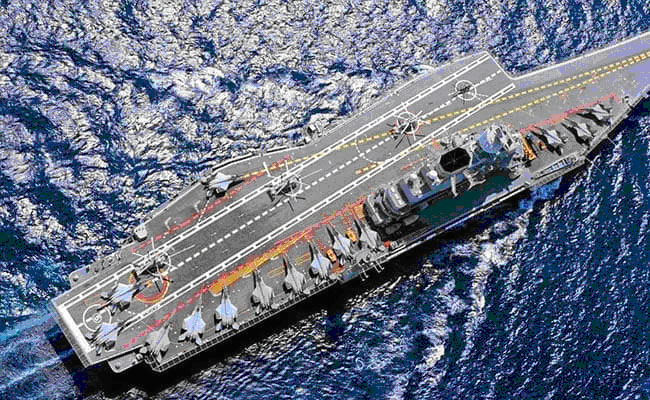When Indian MiGs And French Rafales Bombed A Tiny Island Off Karnataka
Indian and France held bilateral Varuna Naval exercises which saw the largest and most sophisticated deployment of their naval assets ever in the Indian Ocean. Picture shows Indian Navy flagship INS Vikramaditya with MiG-29K fighters deployed onboard
June 10, 2019
New Delhi:
On May 9, sixteen fighter jets, including eight Indian Navy MiG-29Ks and 8 French Rafale-M jets “clashed” over the Arabian Sea off the coast of Karnataka.
The fighters, which were split into two groups of eight each, had their job cut out. One element, designated the strike force, would attempt to hit a small island near Karwar with rockets, bombs and guns while a defensive force of eight MiG and Rafales would attempt to intercept them at beyond visual ranges before they could fire their weapons.
Controlling each element was an airborne early warning aircraft, an E2-D, deployed off the French nuclear powered aircraft carrier, the Charles de Gaulle and an Indian Navy Kamov Ka-31 helicopter which took off from the deck of India’s aircraft carrier, INS Vikramaditya.
Both warships, the de Gaulle and the Vikramaditya were at the centre of the bilateral Varuna Naval exercises, which saw the largest and most sophisticated deployment of Indian and French naval assets ever in the Indian Ocean featuring carriers, nuclear and conventional submarines, destroyers, frigates and support ships. Varuna 2019, which began with air combat exercises off the Karnataka coast, ended up with submarine warfare exercises off the Horn of Africa where the French Navy has a base.
Senior Navy officers who NDTV spoke to have said the air combat exercises added ”exceptional training value” with the attack on the small island off Karwar being one of the highlights. The exercise culminated with the fighters of both sides proceeding to hit targets along the cliff face of the island.

French Navy Rafale-M fighters along with Indian Navy MiG-29Ks in close formation during the Varuna exercises
Key to working together was developing common communication protocols meant to ensure that French and Indian Naval aviators can operate together during a conflict. However, basic operational differences remain. The electronic data-link onboard the Indian Navy’s MiG-29K is not compatible with what the French Rafales operate. As a result all tactical communications (information sharing) between the French and Indian jets were done through verbal communications on radio. Indian Navy officers have told NDTV that the gunnery exercises themselves were very successful with both sides accurately hitting their targets.
Navy officers did not share details of the air to air engagements between Indian Navy MiG-29Ks and the French Rafales. All of these exercises were done at beyond visual ranges of between 60 to 80 kilometres with the Indian Navy sharing that they were able to detect and engage the more-sophisticated Rafale fighter but score-lines of these exercises were not provided to this correspondent. However, Navy sources have repeatedly mentioned to NDTV that none of the exercises involved a straight “fight” between French and Indian forces with both sides deciding to deploy combined forces to maximise interoperability.
The French Rafale fighter is central to India’s plans with the Indian Air Force set to receive the first few of its 36 Rafale jets in September this year. Prior to that, the Indian Air Force will be sending its Sukhoi-30 fighters across to France along with refuelling tankers in early July to participate in the Garuda series of air exercises between the two countries. These jets will fly with and fly against French Air Force Rafales giving the IAF exposure to the advanced fighter that it will soon be in the process of inducting.
Courtesy: TOI

